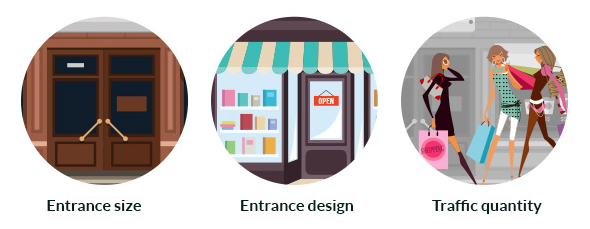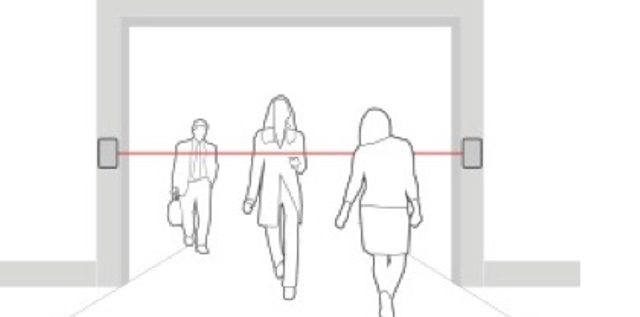Following up on part 1, we now delve in the different technology available and the “technical stuff”. We’ll start with the technology that has been used since the start of the people counting industry, and still used today, the beam, then move on to more advanced solutions and we’ll explain their advantage.
How Effective Are Beam Solutions as Customer Counters?

The beam solution is the “original” method of counting traffic. Even today, beam solutions produce a reliable number and can obtain high accuracy, but their effectiveness is highly dependent on the following:

Firstly, for a beam system to work, it needs a clear line of sight between its two components. These are usually called a receiver and a transmitter.They are installed on each side of the door and this is where point #1 and #2 are important.
Regarding point #1, beams can have a high range (15 to 25 feet is typical and up to 100 feet is possible). If your entrance is extremely broad and/or it possesses displays, such as a table or a rack with items, it could cause the beam to get blocked by the display and render it ineffective. If displays encourage people to stop where the beam is, the person can block it, and sometimes they can obstruct it long enough to avoid the counting of other people entering the location.
Now to point #2- the entrance design. Particularly in malls, entrances have evolved tremendously in the last ten years. Frameless design with glass doors is growing in popularity, which makes the installation of the beam almost impossible because of the effect it would have on the store layout. Also, the lack of a door frame to mount the beam and the fact that the doors now create a backswing that blocks the beam when they are opened make it close to impossible to consider a beam based traffic counting system Regarding point #3, the beam is a passive and simple system. This means that if your traffic flow is high, and two or more people are entering your store side by side at the same time, the beam will only count this as one person.
Where do beams work best?

Based on the above, we can conclude that beams are ideal for small to medium entrances with low to medium traffic flow, where there are no doors or where doors open to the outside. For beams, there also needs to be a clear place to mount them where traffic can flow freely.
Quite a conclusion isn’t it? To keep it simple, beams are best in locations leading to the outside and where the door opens towards the outside. Those locations usually have standard aluminum door frames where the sensors can be mounted, and the opening is at least 6ft (2m) wide.
It must be noted that in a scenario such as a mall, where you have many series of double doors next to each other, and when cutting costs is a necessity, one single pair of beam sensors can be used to cover multiple double doors at the same time. If you decide to do this, you need to know that traffic is low, and that you will rarely have numerous people entering at the same time, OR you’re consciously ready to sacrifice accuracy. Your counts will in most cases still be reliable, but may not be the reality.
As a side note, beams by their design filter out children. Our recommended mounting height for a beam system is 54 inches, which allows for anything below that to be filtered.This means there will be no counts from carts, strollers or children.
Beam systems and especially performant wired systems can be extremely fast. By fast, we mean that two people crossing back to back, even if they are just a few millimeters apart, would register two counts. This is the desired behavior.
In our study, we found that 54 inches proved the ideal height to avoid capturing the same person twice as it is based on chest height. Now, you are probably wondering how a beam system could catch the same person twice? Break the beam you are counted, right? Exactly, but sometimes humans tend to come in with arms swinging. If a beam system is installed too low this may mean two counts, as it is quick enough to capture the arm and then the person. Even if you do not come in arm swinging, you may need to push on the door to open it and usually people extend their arms when this is necessary, but in most cases the arm is below 54 inches. So there is science behind what may seem a random number.
Though Bubble: Consistency/Reliability vs. Accuracy
You may have seen that I vary the terms I use and It is for a good reason. Consistency and accuracy, although connected, are not the same. Accuracy refers to the ability of the system to capture all the people coming in or going out. Count reliability or consistency is the ability of the system to produce results that can be trusted.
Let’s make this clearer. A system that reports on average 85% accuracy but does so consistently can be trusted. A system that reports 100% one day, then reports 50% the next day cannot be trusted, and it will be impossible to make good business decisions with such a system. A consistent and reliable system will allow you to use your traffic patterns to help you forecast- an unreliable system will not.
A beam is not as accurate as the latest and greatest technology but assuming it is always up and running it will produce consistent counts. This is true even if your traffic varies widely from little traffic during weekdays to very high traffic on the weekend. The beam may miss more counts on the weekend but the result will still be higher than during the week and comparable to other Saturdays and Sundays. This will allow you to measure if traffic is up or down and if your performance is improving. The downside is that they might not be the actual real numbers although they will be close to the truth.
The Different Types of Beams
Reflectors vs Rx/tx beams
Reflector refers to a small mirror-like component which reflects the beam back to its emitter. The emitter also acts as the receiver. The principle is the same, if you break the beam, the receiver no longer sees the beam and takes it as a count.
Keep in mind that the reflector models tend to be larger, as the reflector surface usually needs to be large to allow easier adjustment and installation. Nonetheless it works, but there are usually more problems with this kind of model due to a higher chance that the reflector is bumped into. Users also report more problems related to excessive sunlight creating issues, such as missed counts or additional counts.
Rx/tx beams refer to systems that have a “receiver” (rx) which receives the beam and passes the counts to the traffic collector. The transmitter “tx” is the one that generates the beam and these are usually smaller than reflector models. Size varies depending on their power and this is based on the width of the entrance they can cover. These beams are usually considered more reliable although it depends on the manufacturer. The beam system we sell, such as the Mini Beam System and the Wireless System, all use an Rx/Tx.
Thought Bubble
Beams have a lot of advantages as an entry level system but the biggest drawback is caused by their installation points, as they need to be installed on each side of the entrance. That makes them easily accessible for people to tamper with or damage them by accident. They can also be blocked if a sign or a display is put at the entrance and these scenarios can happen often in a wide malls entrances. There is even the potential for disgruntled store managers to cause voluntary blockage. Now, this is usually a mentality problem, as when this happens, they do not really understand the value of the data it provides OR the pressure relative to the increasing performance on traffic is just too high.
Just a quick note on a good solution to this problem: good solutions (such as ours *wink*) can alert you when something is wrong. Having said that, beams are easy to tamper with and if problems happen frequently, whatever the cause, it affects the counts reliability. It’s important to know this when using beam systems and to provide guidelines to your employees to limit these occurrences.
The above example focusses on beams but it is true of for all technologies. The more potential problems that can occur, the more chances your traffic reliability may be affected.
Directional Beams
Directional beams typically have one receiver and one transmitter on each side of the door spaced out slightly. They are bulkier but can provide a separate IN and OUT count. They are more expensive and are only useful if the IN and OUT traffic data is important to you.
They work on the simple principle that if beam “A” is broken and then beam “B” is broken, the person came in.If it is the inverse, then the person went out.
Thought bubble : The value of IN and OUT counts
So should you buy asystem that provides directional counts? The answer really is it depends. It depends on what you want to achieve. I believe that in retail there is limited value. Whatever you decide to do, you either count everyone going IN or OUT as 50%, or count IN only, or count OUT only at 100%. You should just pick one and stick with it. When you think about counting IN and OUT counts, most people believe that this will allow them to know exactly how many people are in the location at a given moment.
The problem with all technologies, but even more so with beams, is that whatever is causing the inaccuracy stacks up throughout the day. If a solution is 95% accurate and we have 100 people entering every hour, then it means that every hour you have 5% false counts or missing counts. Let’s say 5 extra count IN. In that case, the system will now state that you have 5 more people in your store than you actually have. Now repeat similar inaccuracies for 12 hours and as the day progress your occupancy numbers become even more inaccurate. You may end up at closing time with 25 people still in your store, at least according to the system.
Now, we are very interested in occupancy measurements and with a high end system extremely well calibrated for specific scenarios, it may have some value. But for retailers and malls, we believe it is simply not needed and can cause more harm than good.Anyway, all advanced cameras technology offers IN and OUT, but the added cost to do it with a beam system is simply not worth it.
Wireless Beams
Wireless beams can be any type of the beams we listed previously. By wireless, we mean that the beam system does not need a wired connection to a data collector or a power source, and it works with batteries. Beam systems are actually one of the only technologies that can be made to work wirelessly as it does not require much power. A wireless beam system usually modulates the beam, so that it is turned ON and OFF every x millisecond. It makes them slower than wired beam systems but still fast enough.
Some beams go straight to Wi-Fi, but others like our own, can be used as a stand alone by reading the number off the screen and can transmit their counts to a collector box. As an example, our wireless system uses a 2.4ghz protocol that has a lower power than Wi-Fi and communicates with a data collector.Wi-Fi beam systems tend to require more power and have less battery life.
The upside to a wireless beam system is the lower cost and it usually has no installation fee. The downsides are that they require maintenance as batteries need to be changed which can create a potential problem. Also, the action of changing the battery can result in additional problems if done incorrectly (such as the wrong type of batteries being used or batteries put in backwards). Wireless works well and even though it is extremely stable these days, nothing beats a cabled sensor as you can have issues of count transmission using wireless.For these reasons, wireless beams can be the less reliable technology. I say ‘can’ as it will depend again on your goals and needs.
I strongly discourage them for projects where the counts are critical or for any organization that has more than a few locations. Having them in 100 locations can result in a lot of potential problems, that could quickly end up costing you more than starting with a better solution to begin with.
Do not get us wrong: they are the best systems to get introduced to people counting, and they can work well in locations where the person in charge takes their maintenance seriously.
Enough with the beam systems, let’s move on!
Ceiling Mounted Passive Infrared Sensor
This is the same technology used in most motion detection sensors in the security domain. These detect movement based on changes in heat radiation emitted by people or objects. They are mostly wired but it is possible to have battery operated ones.
In the traffic counting industry they are mostly installed over the entrance, covering the lease line of a store. By focusing their detection range, which is often done by reducing their capture zone, we can obtain a system that works very much like a beam.It will be a virtual, straight line at the entrance and when a person walks through that “line” they get counted.
They are usually an inexpensive system, but they have the following limitations:
1. They are sensitive to large and quick temperature changes. For this reason, they are not recommended for installation to count persons coming through an entrance that opens and closes constantlyand is connected to the outside. They are better when installed in locations such as mall stores, where no quick change of temperature occurs.
2. They cannot count more than one person entering at the same time.
3. The depth of their coverage zone is a few inches, sometimes being close to 1 ft. Since they generate counts as soon as they detect movement, and they have a certain reset time when it does (usually .5s to 2s), someone moving very slowly through the coverage zone or staying underneath it could generate numerous counts.
4. They can’t filter out children or strollers.
5. The battery operated sensors suffered the same problems listed in the wireless beam section and battery replacement can be difficult, especially since they are usually installed on the ceiling. Also, changing the batteries can cause them to get out of alignment.
The ideal scenario for them is in a free flowing mall entrance, where they are no displays at the entrance that could cause people to slow down or stand still. In this case, the ceiling passive infrared sensor is a good option.
In part 3, we will discuss people counting cameras, which are now the most commonly used type of customer counter.










